 Leading Blog | Posts by Month |
 Leading Blog | Posts by Month |
09.30.20

LeadershipNow 140: September 2020 Compilation
See more on
Posted by Michael McKinney at 12:02 AM
09.25.20

Ruthless Consistency: The Foundation of Success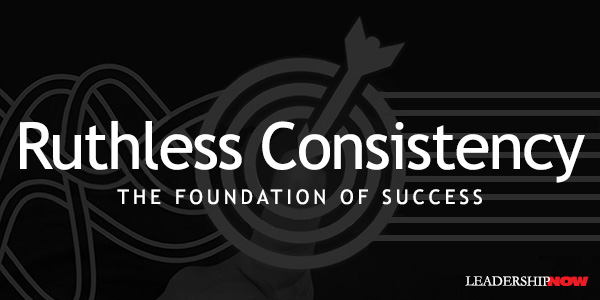
STRATEGIC change fails without consistency—an uncompromising commitment to your stated purpose. A single inconsistent act can call your credibility into question and undermine your change effort. Michael Canic, author of Ruthless Consistency, can help you put the odds of success in your favor. By ruthless consistency, he doesn’t mean robotic repetition. It doesn’t mean inflexible. In fact, “varied and creative are requirements of ruthless consistency, not enemies.” Our changing environment demands it. What he does mean is “the relentless alignment of intentions, decisions, and actions.” Ruthless consistency means that everything you do—as varied and creative as it might be—is consistently aligned with your purpose, your intentions. Three Principles The foundation of ruthless consistency begins with three principles. First, “what matters more than anything you do is everything you do.” Everything you do must be aligned with the direction you want to go to. That involves doing three things: develop the right focus, create the right environment, and build the right team.
“Developing the right focus means identifying and articulating why your organization must change, what you intend to achieve, and how you intend to achieve it. Creating the right environment means aligning every organizational touchpoint, so that your team can and will execute on the right focus. Building the right team means securing the right collection of talent to make it happen.” Canic devotes a section of the book to each ingredient. The second principle is “what you do is not as important as what your people experience.” We naturally look at things from our own perspective, but as leaders, we need to flip that around. “What matters is what they perceive, what they believe, and how they feel.” Canic adds, “It’s not about you. It’s through you. What you do is validated only by what they experience and, as a consequence, what they do.” For people to do what you need them to do and perform at their best, first, you have to understand their perspective. Ultimately, this is about empathy. Seeing through their eyes. Thinking through their minds. Feeling with their hearts. And then taking the right actions. The third principle is “you’re not as committed as you need to be…yet.” What does it take to achieve the result you need, and are you willing to do what it takes to get there? Commitment is best summed up by what I heard a fellow football coach said many years ago: There’s a big difference between the will to win and the will to do what it takes to win. Exactly. And you’d better understand that difference. Many of us have the will to win. We love the feeling of winning. We want to be around winners. But do we have the will to do what it takes to win? What can hold you back as a leader from ruthless consistency? Complacency, distractability, and ego. The first enemy you must defeat is complacency. Are you constantly looking forward? Is your work your passion? Are you immersed in it? People who don’t just achieve success but sustain success have an inspiring next goal. 
Posted by Michael McKinney at 09:06 AM
09.24.20

Leading Thoughts for September 24, 2020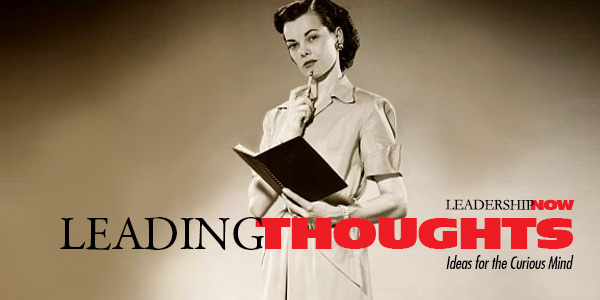
IDEAS shared have the power to expand perspectives, change thinking, and move lives. Here are two ideas for the curious mind to engage with: Steve Farber on doing what you love in the service of people: “It doesn’t matter whether the leaders are in the front or the rear. What matters is the way they are leading the pack. In either case, the leaders are serving other members. The leaders in the front are forging the path, providing direction, and making it easier for others to go where the pack needs to travel. The leaders in the rear are providing support. They are watching over the pack and ensuring that no one is left behind. There might even be some leaders in the middle of the pack because here’s the thing about leaders: they serve others no matter where they find themselves.” Source: Love is Just Damn Good Business Brad Stulberg and Steve Magness on how our passion can eventually lead us astray: “Those who are most focused on reaching some external barometer of success are often the same people who struggle most to enjoy it. That’s because they’ll always crave more. More money. More fame. More medals. More followers. Source: The Passion Paradox Look for these ideas every Thursday on the Leading Blog. Find more ideas on the LeadingThoughts index.
Posted by Michael McKinney at 10:22 AM
09.21.20

Game Changer: How to Be A 10x Talent
WHAT is a 10x talent? 10x talent, as the label implies, is able to deliver ten times more than is expected, but what makes them so valuable is that they are multidimensional. They are smart, good communicators, and have interests beyond their core specialty. Their curiosity and love of learning drives them to do more and do it better. They love what they do, and they love solving problems. In Game Changer, authors Michael Solomon and Rishon Blumberg report that “Tech and digitization have disrupted the very foundation of all ventures, business, government, or otherwise and in doing so have handed over controls to those who have the exceptional skills to provide efficiency and meaningful growth.” The game has changed, and that puts 10x talent in the driver’s seat. In addition, it demands a new kind of 10x management. There are really two sides to this idea. There is the talent, and then there are the people managing and developing that talent. Importantly, those managing the talent should be working to become 10x talent themselves. The first part of the book discusses how to become a 10x company and attract 10x talent. Part two is about how you can become 10x talent. As an organization, you have to give them the opportunity to optimize their whole life—working with the whole person from the inside out. “It’s a level of respect that turns the very concept of boss on its head.” The authors say the most important thing you can understand about 10x talent is that they love what they do. But 10xers are not only high IQ but high EQ. They work well on teams. “Making it on the team is the new success.” And of course, this means openness to feedback. Ralph Perrine, the director of the Innovation Garage, highlighted the gap between the excitement of the innovator and well, everyone else. For him, 10x development “means not only finding a way to communicate your passion, but also finding a way to absorb the other party’s skepticism.” He says, “Driving change is hard. Over time, I’ve learned that our products improve when we’re willing to hear others tell us the many ways things might go wrong.” An important key to all of this is curiosity, humility and therefore, teachability. “Great talent becomes 10x when it develops the quality of manageability—the ability to seek out and internalize powerful outside guidance, built on an invisible desire for growth and improvement.” Tech problems tend to be interdisciplinary in nature, and if you can only do one thing, your value ends when you hit the border of your skills. True 10xers don’t hit that border—they plow right on through and keep learning. The authors introduce what they call the Manageability Continuum, and everyone you meet is somewhere on this spectrum. At one end is the Success Impulse. It is the “internal tendency to make positive choices that steer talents toward both their goals and the company’s goals.” At the other end of the spectrum is the Sabotage Impulse. It is victim mentality. It’s denial. When you see it, run from it. Unmanageability looks like this: “If I can’t tell you the truth, no matter how much nonviolent language I use, if I can’t have an honest discussion about something that’s not working without you personalizing it, without you feeling victimized, then we are nowhere.” Talent will never be enough to overcome the Sabotage Impulse. The manageability test comes down to three questions:
Wherever you are on the Manageability Continuum, you can improve. A 10x manager is someone who wants the best for you, is objective, and can see what you can’t see both personally and situationally. They shine a light on your blind spots. “Following tough advice is takes real grit, especially when you’re already experiencing some success.” No matter how good you are, you will need an outside point of view to learn and grow and make your most important decisions. A 10x manager “dares to study the future in ways you aren’t ready to explore.” They add, “sometimes it’s all about getting a client [a 10xer] to do what he or she does best, but in a new uncomfortable sphere.” The best 10xers wear two hats: the 10x manager and the 10x talent. Anyone with 10x talent should be able to act as a managerial force for others. “Even those 10xers who are individual contributors by choice still need to interact in ways that require management skills. The great news is, by being the manger for someone whose career you genuinely care about, you are receiving a hands-on education in what constitutes receiving strong management. The better you can manage, the better you can be managed.” By helping others, you help yourself. “As the future threatens even greater sweeping changes in the workplace, with technology developing an ever more acute ability to replicate human processes, we believe that the accent on empathy, talent, and mutual guidance can be the guiding light for many and a lifesaver for some.” 
Posted by Michael McKinney at 06:16 AM
09.18.20

Time to Lead: What We Can Learn from Great Leaders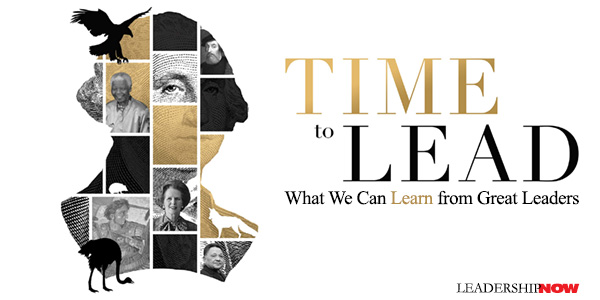
AS professor Jan-Benedict Steenkamp states in Time to Lead, “Everybody can improve their leadership qualities by reading about other leaders, how they resolved their dilemmas, and why they were successful.” Peter Drucker was asked whether he considered himself more of a historical writer or a management thinker: “More a historical writer,” Drucker answered. He explained that the human being has changed relatively little during the known course of history. We therefore gain more valuable leadership insights from historical analogies and examples than by embracing the latest management fads. A quick survey of the world today would suggest that historical knowledge and the lessons we can learn from it, is critically lacking. Steenkamp begins to shore up that deficiency, by looking at the lives of 16 men and women and the decisions they were faced with that changed the course of history. He analyses each in terms of three dimensions. First, he looks for seven leadership traits: Intelligence, Self-Confidence, Integrity, Sociability, Emotional Intelligence, Humility, and Grit. The leaders in the book differed greatly in this area. While some showed no sign of some of these traits, they all demonstrated a high degree of grit or determination. Second, he identifies four types or leadership metaphors: the hedgehog, the fox, the eagle, and the ostrich. Developed from Isaiah Berlin’s expose of the Greek poet Archilochus statement that “the fox knows many smaller things, but the hedgehog knows one big thing.” He writes, “According to Berlin, the distinction between hedgehogs and foxes marks ‘one of the deepest differences, which divide … human beings.’”
Hedgehogs “know much better where they are going (ends) than how to get there (means).” They are guided by a single long-term vision, seeing the forest rather than the trees. On the other hand, foxes “know much better how to get somewhere (means) than where they are going (ends). They are operation rather than strategic leaders.” (As a side note, all of the leaders profiled with the exception of Campbell-Bannerman, exhibited strong hedgehog qualities. However, all were eagles because, in time, they were able to align their means with goals.) Eagles are a combination of the hedgehog and the fox. They “know where they are going (ends) and how to get there (means).” While dealing with the trees they never lose sight of the forest. They are agile and adaptive. Ostriches have neither the qualities of the hedgehog or the fox. They “neither have a clear idea where they are going (ends) nor how to get there (means). Being clueless, they lack a compelling central vision. Next, Steenkamp looks at each leader in terms of seven leadership styles: Adaptive, Persuasive, Directive, Disruptive, Authentic, Servant, and Charismatic leadership. In the appendix of this book you will find three assessment tools: the Grit Scale, the Hedgefox Scale, and SAILS an assessment for leadership styles. Since the point of looking at these leaders live is to learn lessons that we can apply to our leadership today, he chose leaders that could be used to explain a certain leadership style, show the application of a leadership style in practice, prove the possibility of a leadership style across different circumstances, and leaders whose experiences he could derive general insights. In each of the seven leadership styles, he looks at the following leaders: Adaptive Leadership—Modify According to the Circumstances
Persuasive Leadership—Change the Minds of Your Followers
Directive Leadership—Define the Marching Orders
Disruptive Leadership—Break with The Past
Authentic Leadership—Set the Example
Servant Leadership—Put Followers First
Charismatic Leadership—Buy into the Leader, Then Follow Their Vision
All of these great leaders are human and struggle with the same kinds of things we all do. The stories of their lives and the decisions they were faced with are encouraging if only to show that you don’t have to be super-human to face your own critical moments. From these accounts you will see that no one style or set of traits will bring you leadership success. But by learning to understand these leaders in their times, you will begin to understand yourself better. 
Posted by Michael McKinney at 08:05 AM
09.17.20

Leading Thoughts for September 17, 2020
IDEAS shared have the power to expand perspectives, change thinking, and move lives. Here are two ideas for the curious mind to engage with: Jay-Z on excellence: “I think excellence is being able to perform at a higher level over and over again. You can hit a half-court shot once. That's just the luck of the draw. If you can consistently do it through eleven championships like Bill Russell, then that's excellence. Having success for a year or two—that's being hot. We call that hot. That's being in demand for a short span of time. Excellence is being able to perform at a higher level for a long period of time.” Source: Oprah’s Master Class: The Jay-Z Podcast Philosophers Willard Van Orman Quine and J.S. Ullian on the difference between the desire to be right and the desire to have been right: “The desire to be right and the desire to have been right are two desires, and the sooner we separate them the better off we are. The desire to be right is the thirst for truth. On all counts, both practical and theoretical, there is nothing but good to be said for it. The desire to have been right, on the other hand, is the pride that goeth before a fall. It stands in the way of our seeing we were wrong, and thus blocks the progress of our knowledge.” Source: The Web of Belief Look for these ideas every Thursday on the Leading Blog. Find more ideas on the LeadingThoughts index.
Posted by Michael McKinney at 08:36 AM
09.16.20

3 Tips to Lead Strong During Uncertain Times
“Stability breeds efficiency and complacency. Instability breeds resilience and innovation” GIVEN we are in a sustained period of instability, how as leaders do we dial up the resilience and innovation, without burning out ourselves or the teams we lead? How do we leverage the instability to build resilience and innovation that creates success in ourselves and our teams? In my twenty-five-plus years of work, I’ve seen stable and unstable times come and go. And, I’ve seen the patterns of those that come out stronger, and those that don’t. Here are three easy to implement lessons for breeding resilience and innovation in yourself and your team:#1 What You Expose Yourself to Becomes Your Box: I was recently asked how I shifted my business and found success so quickly given the rug was pulled out from under me, like it was for so many. I told them that while many of my colleagues were still talking amongst themselves, I was fortunate enough to have been exposed to new people, new ideas, and hence, new business models. Be intentional and make the effort to expose yourself and your team to different ideas and experiences. Doing this will automatically drive innovation. Their boxes will expand and change, and so will their ideas along with it. #2 Recognize Your Lizard Brains Are Extra Active: In times of stress our primal lizard brain takes over. It’s what creates your fight, flight or freeze response and its main function is to keep you safe and comfortable, especially in uncertain times. The challenge is that the lizard brain shuts down your resilience, your drive to push through. It wants you to curl up in a small ball and wait it out. And while the lizard brain is hardwired into us, with a little effort, we can push past it to get to our higher functioning mind that helps us navigate change and disruption. It’s been my experience that doing something as simple as taking 3-breaths helps get us out of our reactive lizard brain and into our innovative and resilient brain. People that lead strong during uncertainty, don’t give in to the lizard brain, instead, they acknowledge and push through it. #3 Stop Using the Word “They”: In tough times, it’s human nature to want to find something or someone to blame. “They don’t get it,” or “they are the reason I couldn’t get my task done,” or “if only they listened to me.” The word “they” actually creates a victim mindset and minimizes innovation. It’s hard to innovate when people don’t feel trust and connection. A colleague of mine, who has been an incredibly strong leader through 2020, told me that when she sees the word “they” popping up in her team, she shuts it down. In taking out that word, she discovered that people built a more accountable, resilient mindset. And, real connection and collaboration went up, igniting innovation. The key she said, “isn’t to make it punitive, but to help people overcome their blindspots and move forward together.” Instability and uncertainty is definitely challenging, but it can also foster incredible new opportunities and paths to success for yourself, your team and your organization. I’d also encourage you to join me on Sunday, September 20th as I dig even further into how to ignite innovation, influence others and lead strong. This one-time live webinar will cover the 20% that will give you 80% of the innovation results you need to transform uncertainty into opportunity.  
Posted by Michael McKinney at 07:58 PM
09.14.20

Leadership is Language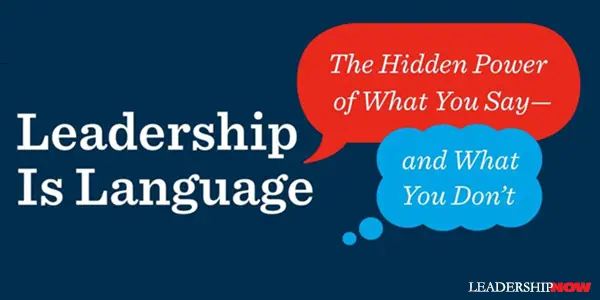
THERE was a time when it made sense to have a group that thought about the work and another group that performed the work. A manufacturing environment lends itself to this kind of structure. The thinkers and the doers. It was the most efficient way to build the momentum of the Industrial Revolution. This structure also helped to reduce variability, which is just what is called for in a manufacturing environment. When Henry Ford began to build his Model T, he didn’t need a lot of freethinkers on the assembly line. What he needed was people to consistently perform in an efficient manner. No variations. Reducing variability was the key to a great manufacturing environment. And we find that the leadership approaches and the language used aligned itself with that goal. This mindset is not only found in the manufacturing environment but just about everywhere else where humans are involved. We quite naturally like to reduce variability. But without variability, we don’t improve. We don’t innovate. We don’t grow. Today the workplace has changed. Along with the velocity of change we see around us comes the need to embrace variability just to stay relevant. We now need the people doing the work also to be thinking about the work. It is this need that David Marquet thoroughly discusses in Leadership Is Language. How we communicate with each other can help us to embrace variability and is our best shot at success. If we are not tuned into this principle, we reduce variability and risk irrelevance or even extinction. We were first introduced to Marquet and the USS Santa Fe, in Turn the Ship Around. In this account, we learn of his efforts to change his leadership approach from leader-follower or thinker-doer to a leader-leader approach that allowed for everyone to lead, think, and do. Moving from a leader-follower dynamic to a leader-leader dynamic requires a change in the way we approach and communicate with one another. This is the subject of Leadership Is Language. Arising from the thinking-doing playbook we have followed since the Industrial Revolution has been an imbalance in the rhythm between doing and thinking says Marquet. “Doing and thinking are the basic building blocks of all human activity. The correct balance of these two activities helps us achieve our goals.” He clarifies: In short, the right balance of doing and thinking drives learning. It keeps the company relevant and solvent. By doing, I mean physical interaction with the world. We need a new playbook. “We need to call the plays that will balance all that doing with more thinking at every level of the hierarchy, not just at the top.” The chart below provides some of the differences between doing, what Marquet calls Redwork, and thinking or Bluework. The key difference is “thinking benefits from embracing variability. Doing benefits from reducing variability.
Bluework sounds like this: “How do you see it? How ready are we for this? What can we do better? And What did we learn?” The Six Main Plays of the New Playbook 1. Control the Clock We are programmed to obey the clock—get it done, keep moving. Controlling the clock is the start of the redwork/bluework cycle. It is the deliberate move to exit redwork and shift to bluework. Controlling the clock is a mindful pause from all of our doing. It’s calling a time-out on ourselves to pause in order to learn, improve, and collaborate. We get there by not just calling a pause, but by making it possible. Avoid statements that erect barriers to questioning and reconsidering a decision, especially in the light of new information. To make it stick, practice doing it. Call a time-out even when no pause is needed. It may be hard for team members to call a pause because they “might be lost in redwork because of the stress of the clock.” 2. Collaborate, Not Coerce Sometimes collaboration is really an exercise in coercion. “Bosses try to be compelling, not curious. They ask leading and self-affirming questions. They suppress dissent and push for consensus. This is not collaboration. This is coercion disguised as collaboration.” “Build consensus” or “Get everyone on the same page” is another way of saying, “I’m right, and you need to change your thinking.” The solution is to let the doers be the deciders. Get their thoughts first before expressing your opinion. Instead of asking yes or no questions, ask how questions. Instead of, “Can we launch on time?” ask, “On a scale of 1 to 100, how strongly do you believe we should launch on time?” And in the face of an outlying opinion, ask, “What do you see that we don’t?” Marquet offers seven ways to ask better questions. “The point is that we do not want a ‘harmonious conversation.’ What we want is an accurate picture of reality.” He also makes a good point with “Give information, not instructions.” Very helpful. 3. Commit, Not comply If you want to keep your commitments, don’t make it about the behavior but more about who you are. Not, “I can’t,” but rather, “I don’t.” Compliance may have worked for simple, physical, repetitive, individual tasks, but it does not work for complex, cognitive, custom, team task. Compliance only gets minimum fulfillment of requirements, whereas commitment invites discretionary effort.
A way to execute this play is to focus on learning by “developing hypotheses to test rather than making decisions to execute.” This makes it easier to shift from redwork to bluework. Rather than “What are we going to do?” create a mindset of “What are we going to learn?” Instead of making a one-time decision, break it up into decision points. Make the redwork a “series of smaller increments divided by bluework decision points.” This was instructive: “Here’s the rule about the blue-red-blue cycle length: shorter periods of redwork increase learning but reduce production output, and vice versa. Therefore, in environments and under conditions of high uncertainty and unpredictability, we need to shorten redwork periods. As the product or exterior conditions become more defined, we can extend the length of the redwork.” 4. Complete, Not Continue The Industrial Age mindset is to continue—to keep on producing—nothing is ever complete. The idea was to maximize the time spent in redwork. Completion marks the end redwork. While in redwork, we benefit by having a prove mindset. However, our overall mindset guiding the redwork-bluework rhythm is on of improve. Focus on the journey, not the destination. When people think of their achievements in terms of mile markers in a journey, they are more likely to continue the behaviors that resulted in them reaching that goal. 5. Improve, Not Prove Improvement is the core purpose of bluework and is meant to improve redwork. Here we reflect, ask questions, and seek feedback. We run the improve play at the end of redwork. Now we need people to do both redwork and bluework. We are all both redworkers and blueworkers. This requires us to be able to step out of our roles as producers and look back at our production with the dispassionate eye of an improver. Marquet offers four ways to execute the Improve play. First, look forward, not backward. “What do we want to remember about this for next time?’’ Second, focus on others rather than the protection of the self. “If someone else had to take over this project, what would you say to them to make it even more successful?” Third, focus on the process and not on the people. This helps to minimize our defensiveness. “How could this be done better?” and forth, seek excellence rather than trying to avoid errors. 6. Connect, Not Conform Connect is the mindset behind all of the other plays, enabling them to work better. It is about caring— “caring what people think, caring how they feel, caring for their personal goals.” Instead of over, it is with. Connect is not a superficial “friendship” but caring for someo0ne else and wanting the best for them. Connect is love. Great takeaway here: “Never underestimate the power of fear to distort common sense in environments with a strong culture of control and compliance.” While Marquet provides ample examples from all walks of life, he concludes with specific examples of how these principles play out in the workplace. The language we use truly makes a difference. Don’t miss putting into practice the insight found here. 
Posted by Michael McKinney at 07:23 AM
09.11.20

Has Your Vision Statement Lost Its Focus?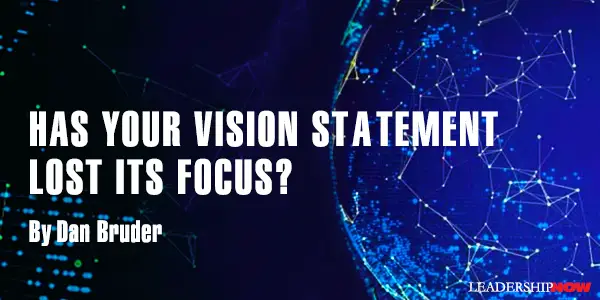
COMPANY vision statements have been a key tool for leaders over the past several decades, but the traditional vison statement does not connect with the wave of new workers. Further, when asked, many senior leaders struggle to remember their organization’s vision. I started observing how vision statements were losing focus several years ago. I was touring a large manufacturing company and, as I walked through the office, there was a gigantic display of their vision statement on the wall. I complemented the CEO on the impressive presentation of their vision statement. He laughed and said, “No one in the company, including me, really knows our vision statement. The truth is, it was a good way to fill up the space on the wall when we moved into our facility.” Later, I was teaching a capstone MBA class and the topic was evaluating company vision statements. After going through the standard overview, I asked the students what their thoughts were on organization vision statements. For the next five minutes, we talked about the textbook definition. I then asked what they really thought about the term “vision.” Still, more textbook answers, until one student brilliantly said, “I think it’s a bunch of crap!” He elaborated (and I paraphrase), calling it just corporate jargon so senior management can tell people a bunch of feel-good stuff that they don’t believe. Finally, I thought to myself, the answer I was looking for—and you won’t find that in the textbook. For decades, there has been discussion about the importance of having a vision statement. As a result, many organizations have gone through the exercise of creating a vision and then having it printed and handed out to employees. Some have even gone so far as to copy and paste it to their email signature. The process typically ends with a vision statement that has no connection to the employees, customers, or community. Thus, the vision becomes a lost statement that does little to move the organization forward. Why have vision statements fallen out of focus? The key reason: they typically do not connect to what drives and motivates employees. Today’s younger workforce does not trust the traditional vision statement where focus is placed on industry or world dominance. Traditional vision statements do not energize or align today’s workers. While competitive dominance and service excellence are nice goals for senior managers, they do not motivate frontline employees. At their core, people get motivated for a cause. A cause gets them out of bed in the morning. A cause keeps them thinking about their contribution even when they are hiking, sitting on the beach, biking, or skiing. A cause brings people together. It is the foundation for extra effort to identify breakthrough solutions. From an organizational perspective, a cause is how I see the world as a result of my company’s behaviors, actions, and habits. A cause solves a meaningful problem. It’s inspirational, motivational, and energizing; it connects with our emotions. Traditional vision statements do not have that type of impact. A group of unified people aligned with a common cause has the power to change the world and lead your organization to its highest potential. A cause makes a bold statement. Consider what Wikipedia aims to create, or its cause: A world where every single person is given free access to the sum of all human knowledge. Teach For America’s cause is equally compelling: All children in this nation will have the opportunity to attain an excellent education. An effective Statement of Cause isn’t restricted to large organizations. Here are a couple of examples from smaller companies:
These are the types of statements that motivate, align, and energize people. A Statement of Cause helps organizations attract and select new hires and evaluate existing employees. It provides the fuel for meetings and the motivation to remain focused. If done right, a Statement of Cause sets the foundation for culture that aligns strategy and influences operational execution. When vision is simply a tagline at the bottom of an email or a sign on the wall, it cannot possibly be the driving force for activating personal and organizational potential. True leaders understand that having a cohesive cause becomes the focal point of the organization, inspiring employees and building a culture that delivers on the brand promise. Great leaders know that a Statement of Cause is the foundational catalyst that enlivens an organization and engages customers, ultimately enhancing employees’ lives, their communities, and all others touched by the organization. Forget meaningless vision. It is time to replace the traditional, old school vision statement with a Statement of Cause.  
Posted by Michael McKinney at 08:14 AM
09.10.20

Leading Thoughts for September 10, 2020
IDEAS shared have the power to expand perspectives, change thinking, and move lives. Here are two ideas for the curious mind to engage with: King of Bhutan, Jigme Khesar, on the importance of self-leadership: “Do not feel alone, small or inconsequential. Too often leadership is associated with one great person giving an inspiring sermon to the masses and leading them to greater heights. Source: Convocation Address at Calcutta University, October 5, 2010 Prime Minister of Albania and former basketball player, Edi Rama on teamwork: “The other team had a superior culture, less focused on individual talent, more on team strength. Culture comes from values and from leadership. To the eternal champions the victory was everything and they were ready to accept any part they had to for the sake of winning; victory was naturally very important to us also, but less important than the performance of each individual. And that meant we were not a team. So we lost. The other team won. Because they were a team. Simple.” Source: Winners: And How They Succeed Look for these ideas every Thursday on the Leading Blog. Find more ideas on the LeadingThoughts index.
Posted by Michael McKinney at 12:07 AM
09.08.20

Stop Making Sense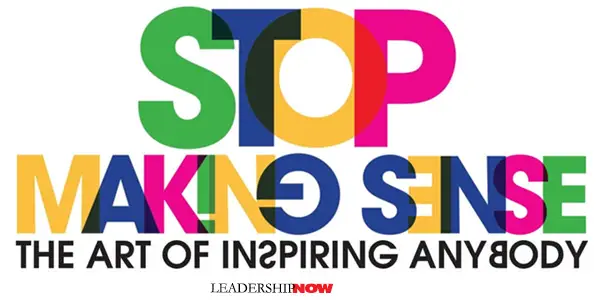
LEADERSHIP is about moving people. And to do that, you need to be able to inspire. And that means arousing their emotions. Marketing strategist Michael Fanuele says to inspire and fuel passion, you will have to Stop Making Sense. “The more we try to persuade—to explain, to convince, to argue—the less likely we are to arouse anybody to do anything.” The Inspiration Equation: Passion – Reason = Inspiration Passion makes you want to sign-up. Reason wants you think about it more. Adding one decreases the other. But there is a place for reason. By all means, use your reason and logic and the full force of your big brain in figuring out what’s right and wrong, what you want to do and what you don’t, in composing your strategy. But then, when it comes to moving people to inspiring, I’m sorry, but Passion and Reason are indeed enemies. You’ll have to find the right balance between adding one and subtracting the other. How can you subtract just enough reasonableness to rile up your audience, without sounding completely insane? The Inspiration Playbook shows you how. It is comprised of six skills of inspiration that will help you execute on the Inspiration Equation. The first two skills are about your goal—what you are trying to do. 1. Get Delusional If we are going to inspire, we are going to have to get uncomfortable and make others uncomfortable too. “Fear, remember, lives closer to success than reason does.” Make your goal big. And use words ending in -est when you talk about it—best, biggest, fastest. A clear idea is an idea that isn’t trying hard enough. It’s graspable. But a sublime idea—a delusional idea that makes you a little nervous because you can’t quite totally see how it will come to be—well, those are the ideas that inspire. 2. Aim For Action Use direction-giving language, so your audience knows exactly what is expected of them. Give them something specific to do in the moment—a plan. And when you want people to do something more, you have to give them a rule to live by—something they can use to filter their decisions. Sometimes—oftentimes—we don’t want to “move” an audience in the moment; we want to shift their very existence. Three and four are about the how. 3. Show Up To Stir Up In a world of sameness, disorienting your audience makes all the difference. When pitching or selling an idea, we often stick to the comfortable and the mainstream. In observing advertising agencies pitching to clients, Fanuele noticed that “their genuine, compelling differences didn’t really matter when they each showed up in a way that felt exactly the same. What they were saying was irrelevant because of how they were saying it.” And when they do, “they sacrifice their most valuable possession: their own narrative.” When we break conventions and become a force for originality, we inspire our audience to break conventions and become a force of originality. 4. Talk Like Music Music moves people because it works on our emotions. If we work on our messages until they arouse our emotions, they become unforgettable earworms. Make it lyrical. Lyrics work “differently than mere speech does. Their intent is not simply to communicate information, but to evoke emotion.” How would your favorite musician retell the story of what you want to achieve? The final two skills are about who you need to become if you are going to be someone’s Muse. They are the most critical and the most difficult. They are about “summoning the empathy and authenticity you’ll need to move anybody to do anything.” 5. Love, For Real Empathy matters. You can’t inspire an audience you don’t genuinely love. Nobody will move for you unless they’re sure you are on their side, looking out for their best interest. So, if you want to inspire, figure out what you love about the people you’re inspiring. This is an act that will require a great deal of effort and imagination, because “what you love” can’t be generic. For example: “Don’t just love their strength, love the way they start Mondays and end Fridays—and never flag in between.” “Love needs details.” 6. Be True To You When people can see our human side, they can connect with us and trust us. We make the mistake of believing that we need to be better than the people we are trying to inspire. Not so, says Fanuele. “Superiority doesn’t inspire. In fact, it often repels. It’s our flaws and imperfections that make us ‘warm and likable.’” I can’t begin to capture here all of the value that Stop Making Sense provides. It will help you approach your job as a leader in a more effective way. “You’ll have to stop making so much sense. You’ll have to be slightly delusional and very vulnerable.” 
Posted by Michael McKinney at 08:30 AM
09.04.20

Just What Do You Mean, Entrepreneur?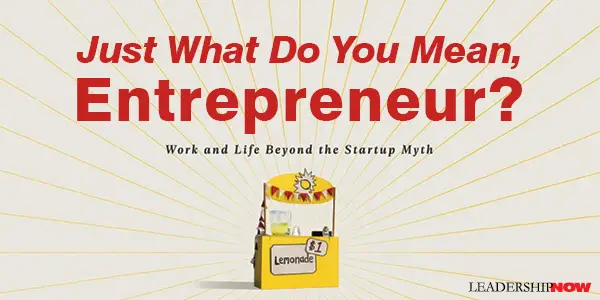
WHEN WE THINK about entrepreneurship, we tend to fixate on people like Steve Jobs, Elon Musk, Richard Branson, Jeff Bezos, and Phil Knight. And why not? There are very few budding entrepreneurs that would not want to duplicate their success. So, we study what these people did to try and find the perfect checklist or formula that brings us the same kind of success. The only problem is this doesn’t reflect the real world of entrepreneurship. David Sax, author of The Soul of an Entrepreneur, says that a startup myth has developed that has “increasingly defined what an entrepreneur was supposed to look like, how they behaved, and what they did. That myth “established that entrepreneurs were brilliant and young, mostly male and white, highly educated lone geniuses who frequently dropped out of college because they were so singularly focused on a brilliant innovation that would transform industry, and maybe even in the world, through economic disruption driven by blitzkrieg growth and fueled by venture capital.” The problem is we have come to define entrepreneurship in terms of this startup model when, in fact, it represents a tiny fraction of what entrepreneurship really is. Many more are lifestyle businesses and self-funded. Furthermore, the highest success rates among entrepreneurs come from founders in middle age and beyond with the average age entrepreneur “behind the fastest-growing new companies (especially in the technology sector) was forty-five years old.” We need to turn our attention to what an entrepreneur really is and why they do it. David Sax began a search for the soul of an entrepreneur. He asks, “Why do entrepreneurs do it? Why do they keep at it, even in the face of tremendous odds, and the daily personal sacrifices, and the imminent threat of financial failure? Why does the entrepreneur matter, why do different types of entrepreneurs matter, and what’s at stake if we lose sight of their value?” These questions lead him around the world to seek out entrepreneurs from all kinds of backgrounds, cultures, and motivations to find the deeper meaning of entrepreneurship. We journey with Sax to a bakery in Toronto run by an immigrant family looking to get a fresh start. For many immigrants, the need to secure some form of financial survival is the prime motivator of their move into entrepreneurship and is referred to as a push factor. Unlike the pull of an entrepreneur pursuing an attractive idea they simply cannot pass up (a romanticized core of the startup myth), a push to entrepreneurship is driven by necessity, often by a lack of better options, a problem that plagues immigrants. We visit Tracy Obolsky in Rockaway Beach, New York, who begins her day with the rising sun surfing before she heads out to open her lifestyle business—a business designed to cover the expenses and lifestyle ambitions of the owner. The lifestyle business captures the soul of the entrepreneur’s essential hope: To be your own boss. To use your talents as you see fit. To wake up each day and do what you decided to do. To reap what you sow, and build your life around that dream, however big or small it is. We also meet Jesseca Dupart in New Orleans. She leveraged her African American beauty products brand Kaleidoscope, to strengthen her community and to help bring more women like her into entrepreneurship. She says, “You are responsible as a successful person to pay it forward … period! As an entrepreneur, I have to tell everybody you can do whatever you want.” Then there are the social entrepreneurs where the donation is a marketing expense that drives growth. This brand of socially conscious capitalism has become romanticized over the past twenty years or so, as a generation of individuals with strong values began to see entrepreneurship as the vehicle for achieving a desired change, in a way that married the dynamism of business with the broad developmental goals that had previously been the realm of governments and multinational organizations. Sax writes, “what separates empty rhetoric from genuine values-led entrepreneurship is sacrifice.” We journey to Argentina to see Iduna Weinert, the thirty-seven-year-old daughter of the founder of the Bodega y Cavas de Weinert winery. The family-owned business does not fit the startup myth where the immediate goal is an exit from the business. The family is often seen as an impediment to entrepreneurship. But in reality, families have always been a part of entrepreneurship. About two-thirds of the businesses owned around the world are owned and operated by families, and in America, “family firms constitute over half of the businesses in the country and half of those listed on stock markets.” Sax notes that “entering a family business does not make a relation an entrepreneur” and few actually succeed into the second generation. But it does become something of a lifestyle. “Knowledge is cumulative and serves as the base for the next generation’s entrepreneurial ideas and the confidence to pursue them.” Sax expands our view of not only what an entrepreneur is, but more importantly, what it means to be an entrepreneur. Sax talks to entrepreneurs that share their ups and downs, successes and failures. And failure is a very real part of owning a business. Uncertainty is a daily part of business. Only two-thirds of businesses survive their first year. The “essential ingredient that links all entrepreneurs together, wherever they are,” says Sax, is hope. The hope that your idea has worth. The hope that it will sell. The hope that you have the ability to change your fortune … for yourself, your family, the community around you, and maybe even the world. That hope is the persistent faith we gather up in ourselves every single day, as we go out and try to make our ideas work. It underpins the personal risk that all entrepreneurs must accept and allows them to manage it, even when that risk threatens to overwhelm them.

Posted by Michael McKinney at 04:49 AM
09.03.20

Leading Thoughts for September 3, 2020
IDEAS shared have the power to expand perspectives, change thinking, and move lives. Here are two ideas for the curious mind to engage with: How to relive stress. It’s not what you instinctively do: “According to the American Psychological Association, the most effective stress-relief strategies are exercising or playing sports, praying or attending a religious service, reading, listening to music, spending time with friends or family, getting a massage, going outside for a walk, meditating or doing yoga, and spending time with a creative hobby. (The least effective strategies are gambling, shopping, smoking, drinking, eating, playing video games, surfing the Internet, and watching TV or movies for more than two hours.)” Sleep helps to beat negativity: “Negative stimuli get processed by the amygdala; positive or neutral memories gets processed by the hippocampus. Sleep deprivation hits the hippocampus harder than the amygdala. The result is that sleep-deprived people fail to recall pleasant memories, yet recall gloomy memories just fine. Source: NurtureShock: New Thinking About Children Look for these ideas every Thursday on the Leading Blog. Find more ideas on the LeadingThoughts index.
Posted by Michael McKinney at 05:05 AM
09.01.20

First Look: Leadership Books for September 2020Here's a look at some of the best leadership books to be released in September 2020. Don't miss out on other great new and future releases not listed here.
The Digital Age will raise the question of how we humans will stay relevant in the workplace. To stay relevant, we have to be able to excel cognitively, behaviorally, and emotionally in ways that technology can't. Professor Ed Hess believes that requires us to become Hyper-Learners: continuously learning, unlearning, and relearning at the speed of change. To do that, we have to overcome our reflexive ways of being: seeking confirmation of what we believe, emotionally defending our beliefs and our ego, and seeking cohesiveness of our mental models. Hyper-Learning requires a new way of being and a radical new way of working.
Our personal experience is key to who we are and what we do. We judge others by their experience and are judged by ours. Society venerates experience. From doctors to teachers to managers to presidents, the more experience the better. It's not surprising then, that we often fall back on experience when making decisions, an easy way to make judgements about the future, a constant teacher that provides clear lessons. Yet, this intuitive reliance on experience is misplaced. In The Myth of Experience, behavioral scientists Emre Soyer and Robin Hogarth take a transformative look at experience and the many ways it deceives and misleads us. From distorting the past to limiting creativity to reducing happiness, experience can cause misperceptions and then reinforce them without our awareness. Instead, the authors argue for a nuanced approach, where a healthy skepticism toward the lessons of experience results in more reliable decisions and sustainable growth.
At age nineteen, Shannon Huffman Polson became the youngest woman ever to climb Denali, the highest mountain in North America. She went on to reach the summits of Mt. Rainier and Mt. Kilimanjaro and spent more than a decade traveling the world. Yet it was during her experience serving as one of the Army's first female attack helicopter pilots, and eventually leading an Apache flight platoon on deployment to Bosnia-Herzegovina, that she learned the lessons of leadership that forever changed her life. Where did these insights come from? From her own crucibles of experience—and from other women. In writing The Grit Factor, Polson made it her mission to connect with an elite pack of tough, impressive female iconoclasts who shared with her their candid stories of combat and career. With its gripping narrative and relatable takeaways, The Grit Factor is both inspiring and pragmatic, a book that will energize and enlighten current and aspiring leaders everywhere—whether male or female.
On the most fundamental level, leaders must bring divergent groups together and forge a consensus on a path forward. But what makes that possible? Humility—a deep regard for the dignity of others—is the key, says distinguished leadership educator Marilyn Gist. Leadership is a relationship, and humility is the foundation for all healthy relationships. Leader humility can increase engagement and retention. It inspires and motivates. Gist offers a model of leader humility derived from three questions people ask of their leaders: Who are you? Where are we going? Do you see me? She explores each of these questions in depth, as well as the six key qualities of leader humility: a balanced ego, integrity, a compelling vision, ethical strategies, generous inclusion, and a developmental focus.
Here for the first time, Hastings and Erin Meyer, bestselling author of The Culture Map and one of the world’s most influential business thinkers, dive deep into the controversial ideologies at the heart of the Netflix psyche, which have generated results that are the envy of the business world. Drawing on hundreds of interviews with current and past Netflix employees from around the globe and never-before-told stories of trial and error from Hastings’s own career, No Rules Rules is the fascinating and untold account of the philosophy behind one of the world’s most innovative, imaginative, and successful companies.
Whether you’re an employer, an employee, a freelancer, or part of a management team, it’s important to understand how—now, more than ever—highly skilled 10x talent who can deliver exponential value is radically shifting the dynamics of corporations large and small. Use this groundbreaking book to learn how to identify, attract, vet, employ, manage, and retain—or become—the game-changing talent that will make a difference in the work world of tomorrow. Individuals, companies and governments around the globe need to understand what tactics are required to survive and thrive in an increasingly global, automated, and post pandemic, distributed economy. The lessons presented in Game Changer reveal those tactics for any industry.
 Build your leadership library with these specials on over 32 titles. All titles are at least 40% off the list price and are available only in limited quantities. “Reading is the nourishment that lets you do interesting work.” — Jennifer Egan
Posted by Michael McKinney at 07:12 AM
|
BUILD YOUR KNOWLEDGE


How to Do Your Start-Up Right STRAIGHT TALK FOR START-UPS 
Grow Your Leadership Skills NEW AND UPCOMING LEADERSHIP BOOKS 
Leadership Minute BITE-SIZE CONCEPTS YOU CAN CHEW ON 
Classic Leadership Books BOOKS TO READ BEFORE YOU LEAD |
|